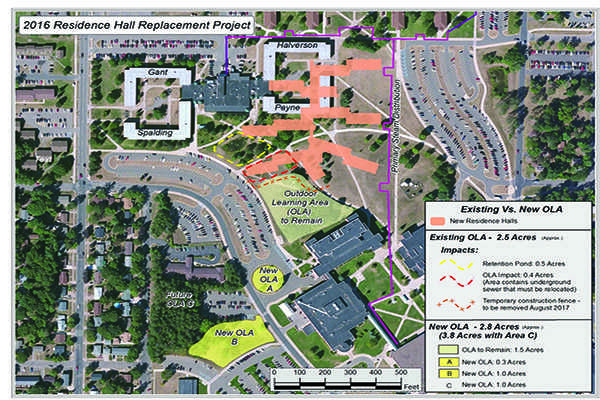Plans to construct a new dorm over a portion of the Outdoor Learning Area (OLA) adjacent to the New Science Facility have students up in arms over the future of the research space. The OLA has been studied as an ecosystem for plants native to the region, as well as pollinators like monarch butterflies for seven years.
That’s soon to change.
NMU President Fritz Erickson said at a Monday, April 11 town hall meeting NMU will lease the land to Tennessee-based EdR Collegiate Housing in a private-public partnership, which is the first such partnership on campus to deal in student housing. NMU will own the property, while EdR, which already has existing sites at Michigan State University and the University of Michigan, will maintain it.
The EEGS department was informed of the plan on Tuesday, April 5.
“[We] will work closely with our students and the University to find the best possible solution to this unfortunate news,” the EEGS department said in an email to students. “With change comes opportunity, and the EEGS Department is excited about collaborating with other groups at NMU to expand into new and larger areas, and about developing more naturalized green spaces for academic and recreational experience on campus.”
NMU’s plan is to tear down Quad 1, which holds 1,200 beds and was originally built with asbestos, a known carcinogen.
When concerns over the proposed plan started floating on Wednesday, April 6, it only took a few hours to organize an impromptu student information meeting to discuss the implications of not having the site. By 5 p.m. room 3710 in West Science held more than 70 students and almost a dozen faculty members for comment, including retired EEGS professor Ron Sundell and Erickson.
Erickson emphasized that only 15 percent of the OLA would be destroyed and that he wanted to work with the EEGS department to find other areas for it. He also stated that much of the area where dorms will be torn down can be reconstituted for more green space.
“I really want this to follow through with the EEGS department,” Associate Director of Engineering and Planning Jim Thams said. “At the end of the day it needs to augment their education.”
He said the plans are slated to be complete in fall of 2018, but the first part of the complex will be finished fall of 2017, where the OLA is now.
Sundell, who retired in June, developed and used the current area since 2009 when it was moved from its original site next to the Learning Resources Center.
Sundell said it’s unfair to other departments to keep the focus on EEGS, as the Biology and Chemistry departments use the site too.
“There’s a lot of people they can bring into this and they won’t,” Sundell said. “Erickson likes tight control over this and I think that’s because EEGS has so few tenured professors.”
At the end of the day, the university owns the site and has jurisdiction over its future. Erickson
said at both the April 6 and April 12 meetings that nothing can be deemed permanent on a college campus.
“I could put something in writing,” he said when asked during the town hall if he would consider signing off that new sites would be permanent. “But in 50 years another president could come in and do something different.”
Sundell said that misses the point. His original vision was to have a research area that will collect ecological data for decades. To him, disrupting that means disrupting ongoing education and research.
“He doesn’t give any thought to the students who worked with that site to make it a sustainable campus,” Sundell said. “He’s chucking that out. I told them they will come here in 20 years and say they were part of this project. Now they’re going to see a dorm there.”
Much of the issue for Sundell is centered around the administration’s narrative. Erickson stressed that only 15 percent of the site will be impacted by the construction, not including the water retention site which will be disconnected from the remainder of the OLA. Sundell countered that not including the water retention pond is misleading.
“[The pond] is the most important part,” Sundell said, noting it keeps car pollutants from the research area. He has documentation dating back to 2001 showing the retention pond was used for native plants research and water quality testing.
“It’s a retention pond,” Erickson said at Monday’s Town Hall Meeting. “It’s runoff from the parking lot.”
The new plans would link the retention pond to storm drainage, which connects to Lake Superior.
“That runoff [will go] right into Lake Superior,” Sundell said. “You’re entitled to your own opinions, but not your own facts. They’re saying it’s 15 percent, when in reality it’s 40 to 45 percent. They’re just rewriting history to fit their development plans.





























